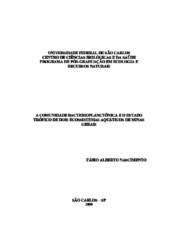A comunidade bacterioplanctônica e o estado trófico de dois ecossistemas aquáticos de Minas Gerais
Abstract
This work analyzed the density, biomass and bacterian biovolume through epifluorescency's microscopy with acridina's orange, they were related with the trophic state
of two aquatic ecosystem in Minas Gerais. The samples were colected in september 1995 (dry season) and february 1996 (rainy season) in the littoral and limnetic zone of Pampulha
reservoir, a eutrofized urban ecosystem, located at north region of Belo Horizonte city, strongly influenciated by the exhaust of the domestic and industrial sewers derived from of its tributaries and by the dumping of garbage by the population around, and in the Olhos d'Água lagoon, a natural urban ecosystem, oligotrophic, and little antropofically influenciated. Significantly differences were founded between physics, chemistry and biological varieties in that two environments. At Pampulha reservoir, the bacterian density oscillated from 0.31 x 106 bacteria/ml and 1.73 x 106 bacteria/ml in the drying season and between 0.31 x 106 and
1.15 x 106 bacteria/ml in the raining season. The biomass oscillated between 50.9 μgC/l and 279.9 μgC/l in the drying season and between 66.6 μgC/l and 205.2 μgC/l in the drying
season. The biovolume oscillated between 0.376 μm3/l and 0.644 μm3/l in the drying season and between 0.377 μm3/l and 0.667 μm3/l in the raining season. In the Olhos d'Água lagoon the density oscillated between 0.15x106 bacteria/ml and 0.19x106 bacteria/ml in the drying season. The biomass oscillated between 9.9 μgC/l and 44.70 μgC/l in the drying season and between 14.70 μgC/l and 28.33 μgC/l in the raining season. The biovolume oscillated between 0.151 μm3/l and 0.728 μm3/l in the drying season and between 0.221 μm3/l and 0.591 μm3/l in the raining season. These results suggest that there is a relationship between the bacterian community and the trophic state at the eutrophic environments where the bacterian community exists with higher results (density and biomass) due to major quantity of carbon available in the environment proceeding from the antropogenic actions. Studies about the quantity of (DOC) dissolved organic carbon, possible relationship among the bacterian and fitoplanktonic communities and predatories taxes of the picoplankton by the microzooplankton are needed at tropical environments to understand the bacterian dynamic in those environments.
